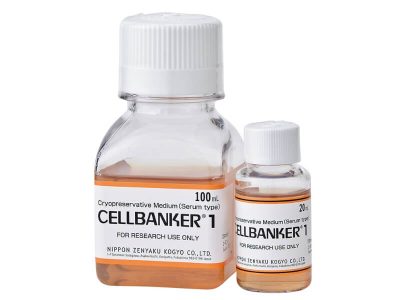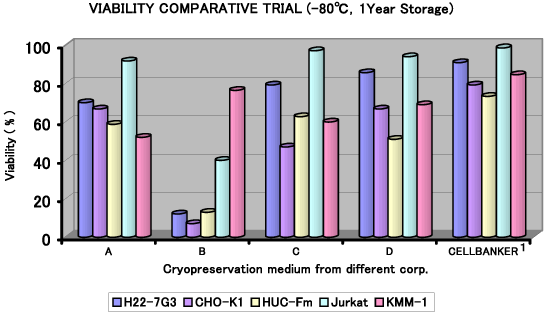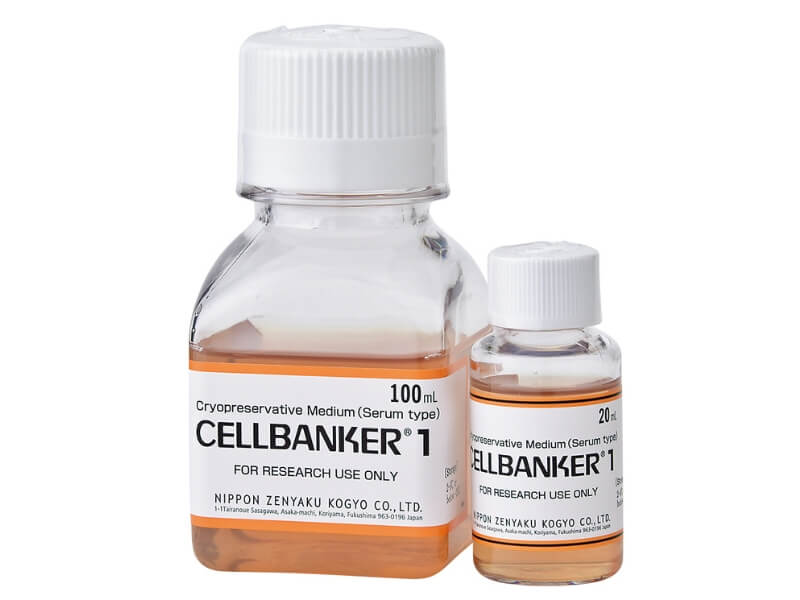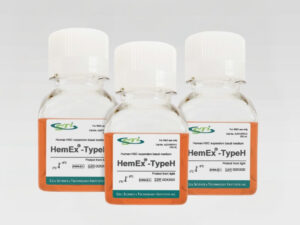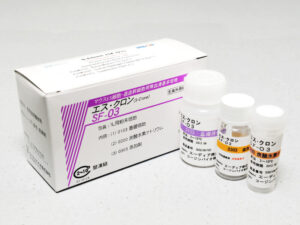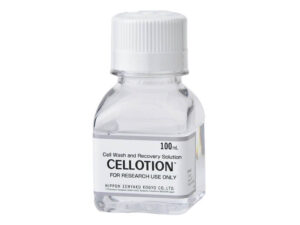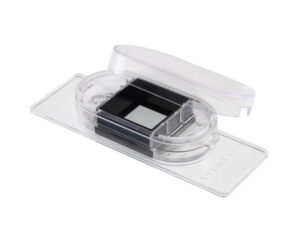CELLBANKER® 1
Preserving standard animal cells, cell lines, tissues & organoids.
Product Basics
CELLBANKER® 1 is a ready-to-use cell cryopreservation medium with a serum-containing formulation suitable for a broad spectrum of mammalian cell cultures. Its unique formulation enables stable cryopreservation and high viability after the freeze-thaw procedure, even for sensitive cell lines.
Key Features
- High cell viability
- Ready-to-use
- No programmable freezer required
- Customizable*
*For more information on customization, please click here.
Technical Information
Experimental results
| Cells | Preservation period (Year) | Viability of cells (%) | |
|---|---|---|---|
| Preserved at -80℃ | Preserved at -196℃ | ||
| MOUSE | |||
| Hybridoma | 10 | 95 | 95 |
| Myeloma | 10 | 90 | 90 |
| L929 | 10 | 90 | 90 |
| FM3A | 5 | 90 | 90 |
| BALB/3T3 | 5 | 90 | 90 |
| M1 | 5 | 90 | 90 |
| YAC-1 | 5 | 90 | - |
| RAT | |||
| RLC-16 | 5 | 90 | 90 |
| NRK | 5 | 90 | 90 |
| PC-12 | 5 | 90 | - |
| HAMSTER | |||
| CHO | 5 | 90 | 90 |
| V79 | 5 | 90 | 90 |
| MONKEY | |||
| COS-1 | 5 | 90 | 90 |
| Vero | 5 | 90 | 90 |
| HUMAN | |||
| Kidney-derived tumor cell | 5 | 90 | 90 |
| EBV transformed cell | 5 | 90 | 90 |
| HEL-derived fibroblast | 5 | 90 | 90 |
| Melanoma | 5 | 90 | 90 |
| Caco-2 | 3 | 90 | - |
| C-5 | 5 | 90 | 90 |
| CEM | 5 | 90 | 90 |
| K562 | 10 | 90 | 90 |
| Jurkat | 10 | 90 | 90 |
| BALL-1 | 5 | 90 | 90 |
| HUC-Fm | 5 | 80 | 80 |
List of Cells Tested [PDF] – Cell types are constantly being added. Please contact us if you cannot find your cell listed.
Protocol
Freezing
For optimum results, cells for cryopreservation should be in log phase of growth. Similar or other standard freezing protocols may be substituted.
- Examine and make sure the cell culture is free of contamination, in healthy and at proper confluency.
- Perform a cell count to determine the viability of cells.
- Centrifuge at 1,000 – 2,000 rpm, 4°C for 3 to 5 minutes to gently pellet the cells. Remove the supernatant with an aspirator.
- Gently suspend STEM-CELLBANKER® GMP grade cryopreservation medium (1 mL for 5×10⁵ – 5×10⁶ cells).
- Transfer 1 mL of the cell suspension to cryopreservation vial labeled with appropriate information (the cell line name, concentration, passage date etc.).
- Place the vials directly in -80℃ for storage.
- (OPTIONAL) Transfer the frozen vials to a liquid nitrogen storage tank after the vials have been frozen for at least 24 hours.
IMPORTANT: Optimum protocol may change with the cell types.
Thawing
- Remove the cryopreservation vial from the freezer and quickly thaw cells in a 37°C shaking water bath or shake by hand.
- Transfer the content to a centrifugation tube then immediately dilute and gently mix with 10mL of complete cell culture medium. Using CELLOTION® instead of complete culture medium will prevent adhesion of cells to the wall of the tube, increasing the recovery rate.
- Centrifuge cells at 1,000 – 2,000 rpm, 4°C for 3 to 5 minutes. Remove the supernatant with an aspirator.
- Gently resuspend the cells with an appropriate volume of complete cell culture medium then plate in a culture flask or plate
- Continue the culture procedures according to standard protocols.
Specification
- Manufactured By : Zenogen Pharma Co., Ltd
- Size : 20mL (SKU: 11911), 100mL (SKU: 11910) & 20mL x4 (SKU: 11911-S)
- Storage and Stability : 2 to 8℃ or below -20℃
- Expiration date : 3 years after the date of manufacture
- Disclaimer: For research purposes only
Pricing
CELLBANKER® 1
- Cryopreservation of many of animal cells
- Cryopreservation of common cell lines
- Bovine serum
20ml size
SKU: 11911
Price: $35.00
100ml size
SKU: 11910
Price: $160.00
20ml size x 4
SKU: 11911-S
Price: $135.00
References & Literature
Lee, H.-O. et al. Lineage-dependent gene expression programs influence the immune landscape of colorectal cancer. Nature Genetics 52, 594–603 (2020) doi: 10.1038/s41588-020-0636-z.
Wang, Z. et al. mRNA vaccine-elicited antibodies to SARS-CoV-2 and circulating variants. Nature 592, 616–622 (2021) doi: 10.1038/s41586-021-03324-6.
Shinozawa, T. et al. High-Fidelity Drug-Induced Liver Injury Screen Using Human Pluripotent Stem Cell–Derived Organoids. Gastroenterology 160, 831-846.e10 (2021) doi: 10.1053/j.gastro.2020.10.002.
Parajuli, B. et al. Transnasal transplantation of human induced pluripotent stem cell-derived microglia to the brain of immunocompetent mice. Glia 69, 2332–2348 (2021) doi: 10.1002/glia.23985.
Oguri, S. et al. Effect of varying storage conditions on diagnostic test outcomes of SARS-CoV-2. J Infect 83, 119–145 (2021) doi: 10.1016/j.jinf.2021.03.026.
Yoshida, J. et al. Mitochondrial complex I inhibitors suppress tumor growth through concomitant acidification of the intra- and extracellular environment. iScience 24, 103497 (2021) doi: 10.1016/j.isci.2021.103497.
FOR RESEARCH USE ONLY, NOT FOR USE IN DIAGNOSTIC PROCEDURES
